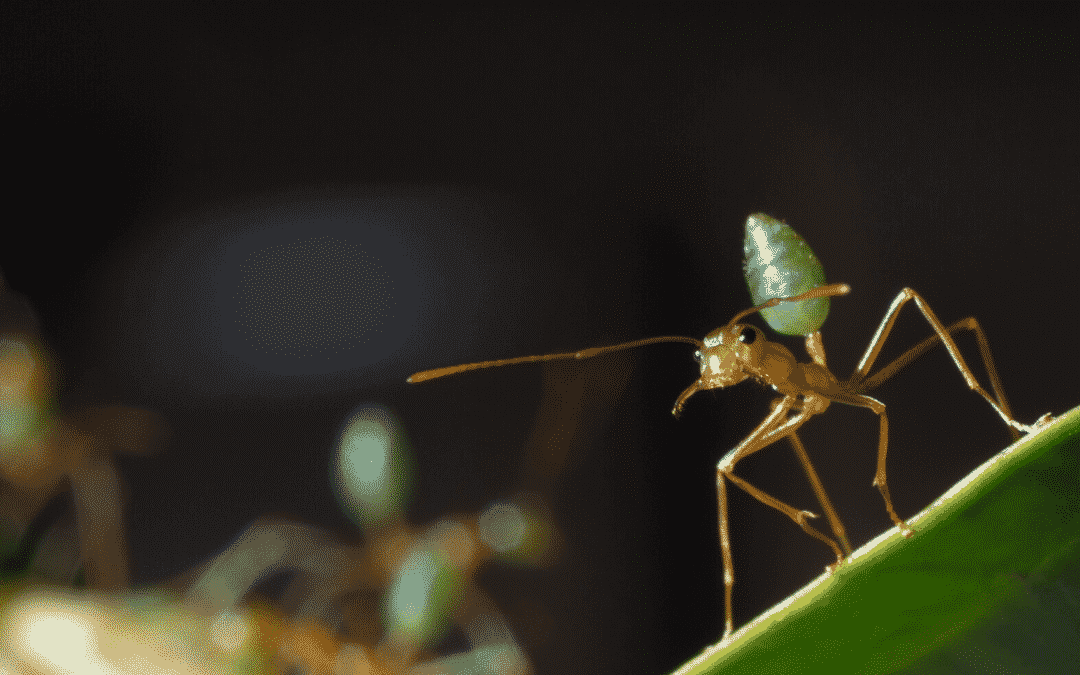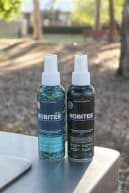So many people who are planning their move to Australia ask me about Australian bugs, spiders and snakes! I know lots of people who say they could never move to Australia because of all of the insects in Australia and the dangerous wildlife here. I admit, there are some dangerous creatures here that you need to be aware of (I’ll cover those in a separate post in more detail soon but in the meantime, you can learn some wildlife facts in this post) but Australian bugs aren’t something you need to be afraid of.
My boys were obsessed with catching creepy crawlies, butterflies and bugs in the UK, so I was scared they’d want to catch Australian bugs and insects when we arrived here. Thankfully even though our twins were only four when we arrived, they listened to us and didn’t go around hunting Australian beetles. Now they’re older and more confident with understanding the wildlife and knowing the Australian bugs that bite, they love looking at insects here.
We get some pretty cool big insects in Australia (like the incredible praying mantis and giant crickets!) Honestly, rather than being scared of the bugs here, I’m mostly just in awe of nature (apart from ants. I’m not in awe of ants. I’d be quite happy if they didn’t exist!).
Anyway, I think it really helps to understand more about the bugs of Australia so you can see they’re mostly harmless!
This post about Australian bugs contains affiliate links.
Quick overview of bugs, Australia
It’s handy to know about the biting insects Australia has just so you can take care to avoid them where possible. It’s also helpful to learn a little about the insects from Australia and common household bugs in Australia so you know what to expect if you find any insects or creepy crawlies in your house! Understanding a little about Australia bugs can take the fear away.
In addition to Australian native insects, there are also actually some non-native bugs and insects here too that were introduced (who on earth was responsible for bringing European wasps over to Australia – why would you do that?! Who knows, but at least they don’t exist in Queensland!!)
If you’d like to learn more about Australian insects and bugs in-depth, here is a great book to get you started…
Shop for Insect books on Australia on Amazon
Ants in Australia
I’ll begin with the thing I dislike the most! Ants were never something that particularly bothered me in the UK, but here (in Queensland at least) it’s a different story. There are a lot of species of ant, and some of them are REALLY painful when they sting. Some ant stings can even last for 24 excruciating hours. Bull ants, jack jumper ants, green ants and fire ants are some of the painful varieties. Ant stings can really hurt in the moment, and they can continue to produce waves of pain over and over.
Having been caught out before, I now always carry bite cream and antihistamines in my handbag (having a mini first aid kit in your bag is always a good idea, especially when you have little kids). These critters can be really painful and they can get you when you’re just standing still (my worst bites have been while waiting for the kids at the school gate). My son has been unfortunate enough to sit on a green ants nest before too – poor thing.
A few times, my dog has got an ant trapped between the pads of his paw and cried and cried in pain til I found out what was causing his limp (as he was being repeatedly stung). They burrow into the fur and can be really difficult to spot, and even harder to pull out when hiding between paw pads so if ever your pup cries and limps in pain on a walk this might be the reason (both times he literally dropped to the floor and couldn’t walk because of the pain).
There are lots of other Australian ants that are harmless, so they don’t all sting you. In Queensland, we also get ants in the kitchen sometimes as it is hot and humid here so they can be a pest in your home, too.
It’s best to avoid sitting on the grass directly and make sure you check the ground for nests when putting a picnic rug down. If you live in a tropical location, keep your kitchen work surfaces clean.
Wasps in Australia
Something I definitely don’t miss from the UK is wasps that seemed to follow you all over the place during summer! However, doing research for this article I’ve found that European wasps do live in Australia – just not Queensland (lucky for me!) You can learn about where you can find them on the Australian Museum site here.) In Queensland, you can eat and drink outside without being chased by wasps and I rarely see any around other than mud wasp nests sometimes around the exterior of our house.
There are lots of different wasps in Australia – apparently, over 12,000 species! Black wasps, mud wasps, cuckoo wasps, spider wasps, yellow jackets and fig wasps are just some of the ones you’ll find here. But as I said, they don’t chase after you like the UK ones did and generally I hardly see any around.
If you see a big flying insect, you’re best not to touch it. And just take care while gardening – I once got stung multiple times while trying to cut down some branches from a bush here. I have no idea what the wasps were as I didn’t see them but I ended up with about eight painful stings up my arms! Now I’m more cautious and aware before I jump in and start cutting things down.
Mud dauber wasps are a common wasp that I do see in our garden. Apparently, they’re good to have around as they control spider numbers and benefit your garden too.
Native Australian bees
I have a real soft spot for Australian native bees. I’ve done a few fun bee tours over the years (at The Ginger Factory on the Sunshine Coast and at HoneyWorld on the Gold Coast). There are over 2000 species of native bee, and some of them as as tiny as 2mm! They are an integral part of our environment and our agriculture here. We even get stingless bees in Australia which are great for pollinating crops and they make a unique tasting honey.
If you’d like to learn more about native Australian bees, check out this book…
Shop for A Guide to Native Bees of Australia on Amazon

Dragonflies and damselflies in Australia
I love watching dragonflies in Australia. You tend to find them around water and, in Queensland, we have a species that grows up to 170mm. It’s pretty incredible to think that dragonflies have been around for 300 million years (with rather larger versions being around at the time of dinosaurs). During breeding season, brightly colour wings are used to attract a mate. While they aren’t a dangerous Australia insect, dragonflies can bite for protection (although it’s not a dangerous bite). They fly so quickly though that you’re not likely to get that close to one!
Cockroaches in Australia
I dislike cockroaches – they have special antennae which is how they are so aware of their surroundings as you try to catch them in a glass! Not only do they scuttle around at super speed, but they can also FLY (I may have screamed the first time I realised this when one I was trying to catch flew right at me!)
Australian cockroaches can be between 3 and 4cm long and they’re usually a brownish colour. They are likely to be found around your kitchen and bathrooms, although they really can appear anywhere in your home.
While these Australian bugs aren’t actually going to bite you, they are a top Australian pest as they pick up all kinds of nasty bacteria and transport it all over your home. You don’t want them living with you and traipsing their dirty feet all over the place.
If you only find them in your home occasionally, you can catch them and put them outside (or spray them with a bug spray if that’s your preference). Try to make sure any gaps are filled where they could be getting in. Do your best to keep your home clean – make sure food is well sealed and not left out. If you find multiple cockroaches though, it’s time to bring in a pest controller to spray your home. Once you’ve had your home sprayed, you’ll begin finding dead cockroaches for a few days and then you should be able to live cockroach-free for a while.
Some houses seem to get lots of them (our first rental home got lots), others don’t (the house we live in now 20 minutes up the road rarely has them). Just know if you do see them in your home, there is something you can do to get rid of them so you definitely don’t need to live with them (and ditto spiders – the pest spray will ensure your house stays spider-free as well). Pest control companies usually recommend having a spray done every six or 12 months.
Termites in Australia
Termites build giant termite nests in soil or wood, and they can cause havoc to the wooden structures of your home. There are hundreds of species of termite, so not all of them are home-eating pests – some live a peaceful life eating grass!
There is usually just one Queen and a King (plus young Queens and Kings in the making that are being prepared to possibly take over the roles in future) along with workers (that gather food, build and maintain the nest and take care of the young) and soldiers who defend the colony.
It’s important to be termite-aware as your home can be in serious danger of costing you a small fortune if you get a termite infestation. This is the reason you will need to get a pest inspection done when you buy your home in Australia. So although termites aren’t dangerous, they can be really expensive pests!

Bed bugs in Australia
Bed bugs in Australia aren’t something I like to think about! These small, oval flat shaped insects feed on blood at night time. They are a pest that can be difficult to get rid of, so it’s worth just being aware of them even though personally I’ve never met anyone affected by them thankfully. *shudders*
Praying mantis in Australia
Australia has an estimated 160 species of praying mantises. They have big, bulging eyes set apart on their head, plus three more eyes on the top of their head. These stick-like Australian bugs come from eggs that take between 40 days and five months to hatch. Some species have wings and the adults can fly. For some species, the female eats the male after (or during) mating. They’re fascinating to look at and we often get one land on our patio door or pool fence. They will eat other insects but aren’t dangerous to humans.
Mosquitos in Australia
Mosquitos are one of the most dangerous insects around purely because they can carry diseases. There are more than 300 species of mosquito in Australia and they can carry various viruses so it’s worth avoiding being bitten. Dawn, dusk and night time are the times they’re most prominent. They’re very common where we are in Queensland where we live.
My daughter and husband get bitten terribly and their skin reacts badly to bites.
Take care by wearing long sleeves and trousers, and applying insect repellent and avoiding being outside at night time when they’re around. Some times of the year are far worse than others.
Keep a good antihistamine (cream and medicine or tablets) in stock to help ease the itch and pain from mozzie bites.
Shop for NoBites Mosquito repellent on Nourished Life
Australia insect information
I hope this little overview of Australia’s insects helps to prepare you. I know when we moved here, we knew nothing at all about Australian bugs or Australian insect identification – it’s something we’ve learned more about as we’ve lived here and encountered more wildlife but I know it would have been handy to know some of the basics before we moved.
You can learn more about Australia in this Australia Guide.



















